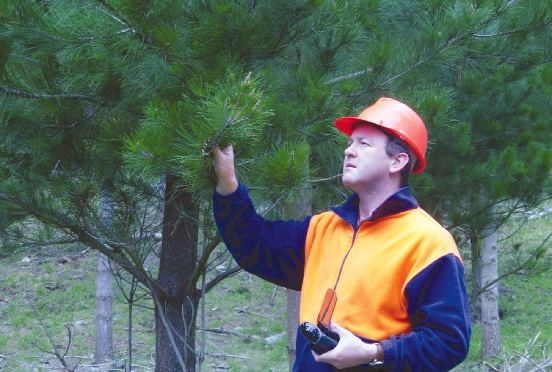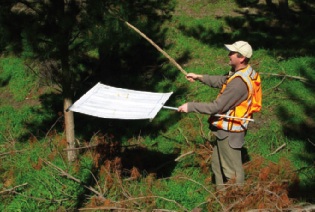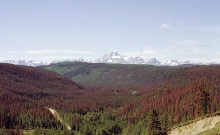PESTS AND DISEASES OF FORESTRY IN NEW ZEALAND
Keeping an eye on our plantation forests
From Biosecurity 89, February 2009.
To provide an additional line of defence, the forest industry, through the New Zealand Forest Owners' Association (NZFOA), runs a Forest Health Surveillance System (FHS) across its members' more than a million hectares of plantation forest. This scheme has been operating for more than 50 years, although adjustments have been made to the design and implementation as additional knowledge has come to hand.
What is the FHS?
The FHS is implemented on an annual basis and tendered, through the NZFOA, to forest health providers. SPS Biosecurity Ltd currently provides the bulk of the service, and a smaller area is surveyed by Baigent Pest Control. Forest health providers are required to conduct aerial and ground surveys, followed up by more intensive plot investigations where results from aerial surveys warrant it. All staff are well trained in forest biosecurity investigations and provide a dedicated service to the industry.

Increasing attention is paid to what are termed "High Risk Forest Sites". These sites are where there is considered an increased chance that new organisms could be found. These are often associated with risk pathways such as machinery movement, heavy industry and recreation.
A critical component of the FHS is the collection and diagnosis of suspicious samples collected in the field. These are sent to the Crown Research Institute Scion, where they are quickly analysed to determine if there is a potential threat to the forest plantation. With the development and introduction of molecular techniques, this service is becoming very sophisticated, not unlike that provided for crime scene investigations.
The FHS is funded by forest owners through a voluntary levy, which also provides funding to cover research and the administration of industry forest health activities. While the cost appears nominal on a per hectare basis, the amount becomes significant across the million-hectare estate of NZFOA members.
Who are the forest health providers?
The main forest health provider is SPS Biosecurity Ltd. The directors (Paul Bradbury and Brent Rogan) have each been involved in the quarantine, forestry and biosecurity fields for over 20 years and have worked for a range of government agencies, private companies and research organisations. In mid-2007 they saw an opportunity for a specialist private provider of environmental and biosecurity services and established SPS Biosecurity Ltd. Mr Bradbury and Mr Rogan are well supported by a highly experienced team of well-qualified forest health professionals.
As well as conducting the bulk of the FHS work, SPS Biosecurity staff are also involved in the MAF-operated High Risk Site Surveillance, along with other forest health and biosecurity operations. Thus they are able to provide a sound overview of what is being done throughout New Zealand in biosecurity surveillance.
What do they find?
The forest health providers are specifically looking for new and potentially dangerous pests and diseases that have been introduced to New Zealand's plantation forest estate. However, the expectation and hope is that few, if any, will be found. To date this has been the case, although the plantation forests do have several well-established diseases that are monitored, such as Dothistroma and Cyclaneusma needle casts. The forest health providers report on the extent and intensity of these forest health issues to the respective forest owners and may also provide additional information on other aspects of forest condition, such as nutrition and snow damage, as required.
How well does it work?

The NZFOA conducts periodic audits of the FHS to ensure it is working as designed. In November 2007, it commissioned a major external review by two overseas experts: Dr Andrew Liebhold, a research entomologist with the United States Department of Agriculture (USDA) Forest Service in Virginia, and Dr Brenda Callan, a pathologist with the Canadian Forest Service in Victoria, BC. They concluded: "Overall, we found the FHS system to be well-conceived, valuable to the New Zealand forest industry and generally well executed. The program deserves commendation as part of a progressive approach to forest biosecurity that exceeds the sophistication level attained by forest health surveillance programs elsewhere in the world."
The reviewers also recognised the role the Government played in providing a "world leading" level of biosecurity effort, which had resulted in the exclusion of many serious pests, and the forest industry's foresight for "advancing a highly progressive approach to alien pest exclusion". Much of the credit for the success of the forest surveillance programme could be attributed to the forest health providers' staff. "These individuals are the 'eyes' of the program and their skill, dedication and hard work are evident, as is the very competent diagnostic service provided by NZFRI (the New Zealand Forest Research Institute, Scion) in analysing field samples. Accomplishing this goal is no simple matter given that causal organisms may often be cryptic and difficult to identify (e.g., species that are new to science or previously not associated with a particular host or disease complex)."

Despite the top marks scored from the review, the NZFOA has made several minor adjustments to the current system in line with the review's recommendations. In particular, increased attention is being focused on high-risk sites, where there is a greater likelihood of new pests and diseases being found.
How does the FHS work with MAF?
The FHS system is closely linked to MAF biosecurity operations, and new organisms identified are recorded in the MAF biosecurity database. Additionally, the FHS High Risk Forest Site network is modelled after MAF's High Risk Site network, and similar investigative procedures are used for both. There has been a long-standing partnership between the forest industry and MAF to protect New Zealand's plantation and native forests from biosecurity threats. To date, this has worked well and the most damaging agents have been excluded.
Bill Dyck, science and technology broker and NZFOA Forest Health Administrator

 Farm Forestry New Zealand
Farm Forestry New Zealand

